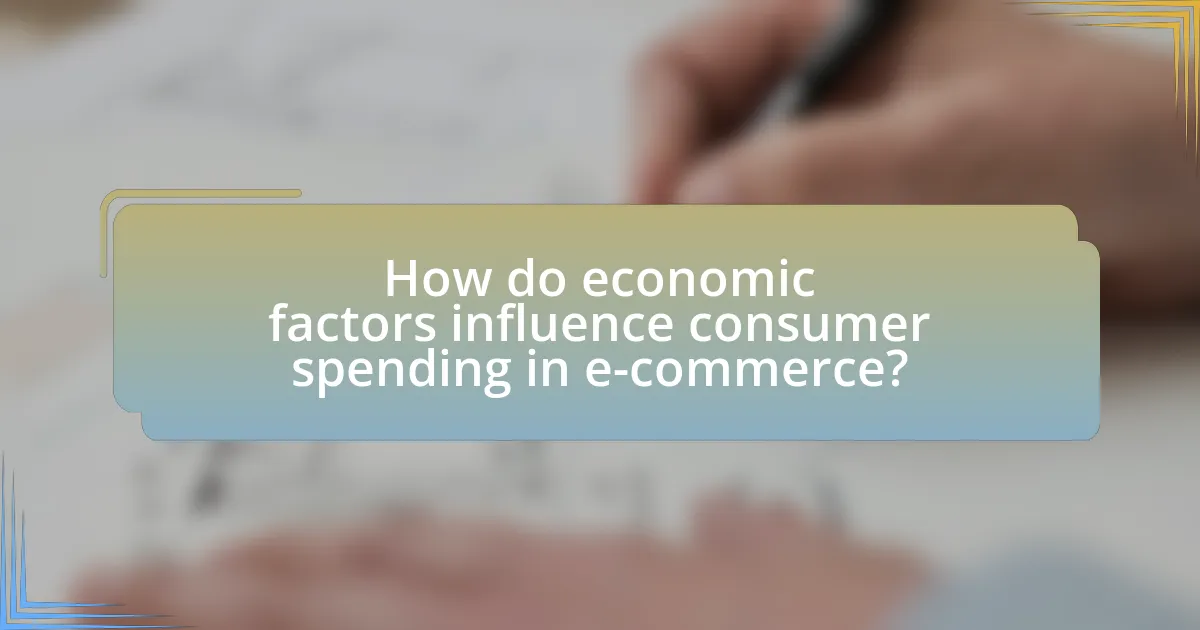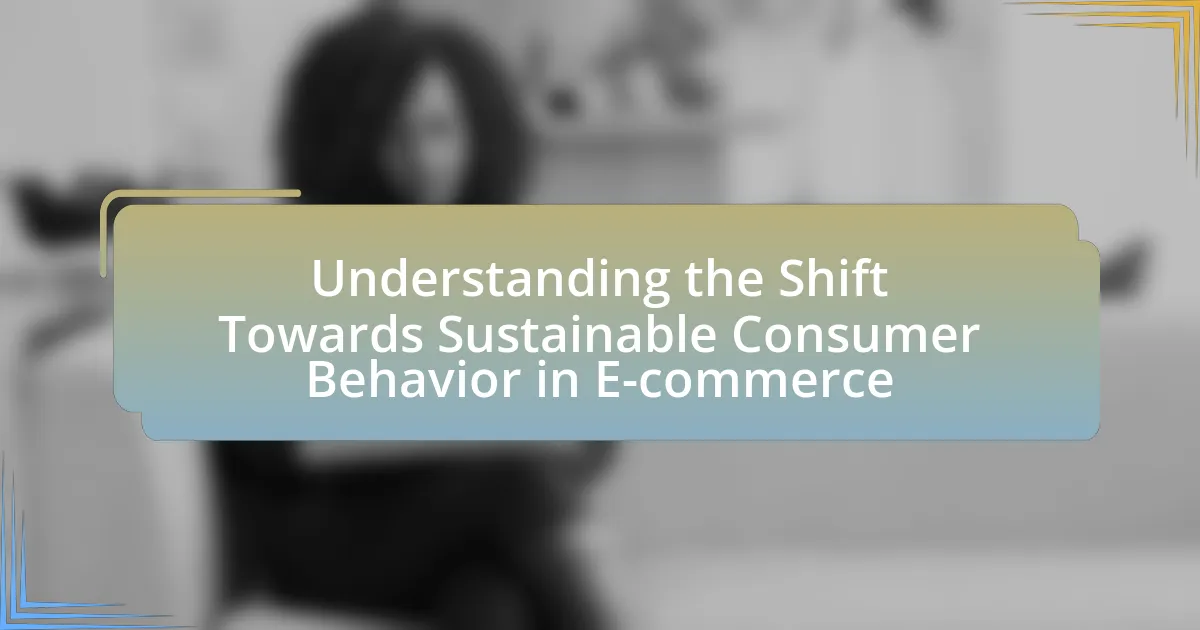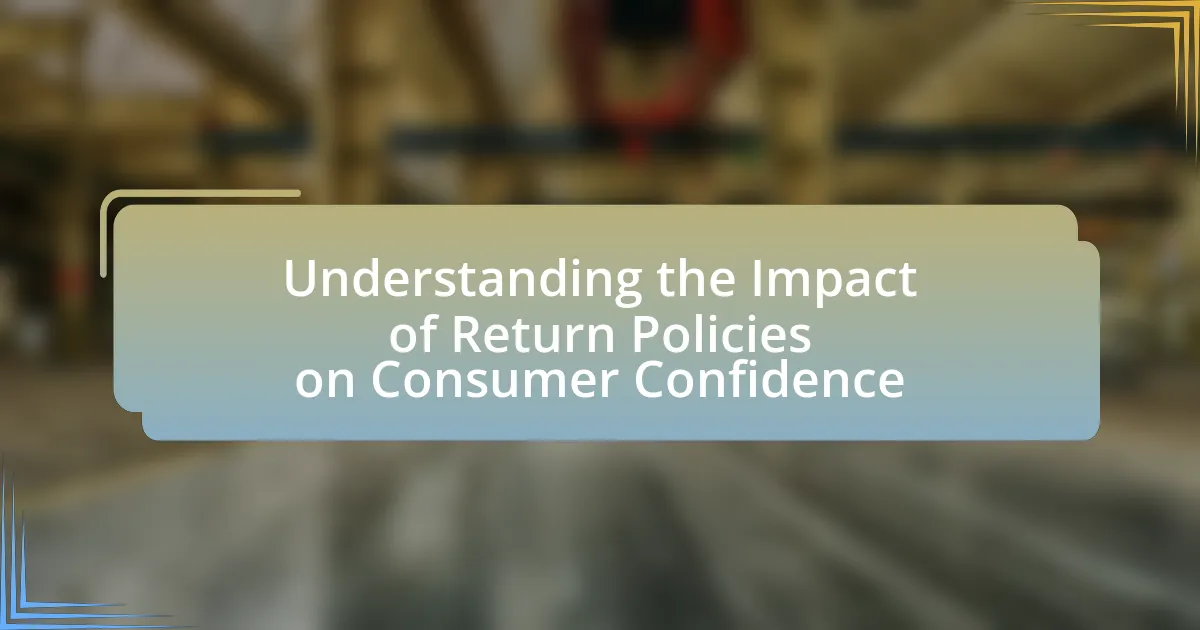The article examines how economic factors influence consumer spending in e-commerce, focusing on key elements such as disposable income, consumer confidence, inflation, and interest rates. It highlights the direct correlation between these economic indicators and consumer behavior, illustrating how changes in income levels and economic outlook can significantly impact online purchasing patterns. Additionally, the article discusses strategies for e-commerce businesses to adapt to economic fluctuations, including pricing adjustments and enhanced marketing efforts, while also addressing demographic variations in spending habits. Overall, it provides a comprehensive analysis of the interplay between economic conditions and e-commerce consumer behavior.

How do economic factors influence consumer spending in e-commerce?
Economic factors significantly influence consumer spending in e-commerce by affecting disposable income, consumer confidence, and overall economic conditions. For instance, when disposable income rises due to economic growth, consumers are more likely to spend on online purchases, as evidenced by a 2021 report from the U.S. Department of Commerce showing a 32.4% increase in e-commerce sales during the pandemic, driven by increased disposable income. Additionally, consumer confidence, which is often tied to economic stability, impacts spending behavior; higher confidence levels correlate with increased online shopping, as seen in the University of Michigan’s Consumer Sentiment Index, which indicated that consumer spending tends to rise when sentiment is positive. Overall, these economic factors create a direct link to consumer behavior in the e-commerce sector.
What are the key economic factors affecting consumer behavior?
Key economic factors affecting consumer behavior include income levels, employment rates, inflation, and interest rates. Income levels directly influence purchasing power; higher income typically leads to increased spending on goods and services. Employment rates affect consumer confidence and stability, as higher employment generally correlates with greater consumer spending. Inflation impacts the cost of goods, leading consumers to adjust their spending habits based on price changes. Interest rates influence borrowing costs; lower rates encourage spending and investment, while higher rates may deter consumers from making large purchases. These factors collectively shape consumer behavior in the e-commerce landscape, as they determine how much consumers are willing and able to spend.
How does consumer income impact e-commerce spending?
Consumer income significantly impacts e-commerce spending, as higher income levels generally lead to increased online purchases. When consumers have more disposable income, they are more likely to spend on non-essential items and luxury goods through e-commerce platforms. For instance, a report by the U.S. Bureau of Economic Analysis indicates that as personal income rises, consumer spending on goods and services, including e-commerce, tends to increase. Additionally, a study by Statista shows that in 2021, households with higher income brackets spent substantially more on online shopping compared to lower-income households, highlighting the direct correlation between income levels and e-commerce expenditure.
What role does inflation play in consumer purchasing decisions?
Inflation significantly influences consumer purchasing decisions by eroding purchasing power and altering spending behavior. As inflation rises, consumers face higher prices for goods and services, leading them to prioritize essential items over discretionary spending. For instance, a report from the Bureau of Labor Statistics indicated that a 5% increase in inflation can lead to a corresponding decrease in consumer spending on non-essential goods by approximately 10%. This shift occurs as consumers adjust their budgets to accommodate rising costs, often resulting in reduced overall consumption and a focus on value-oriented purchases.
How do interest rates affect consumer spending in e-commerce?
Interest rates significantly impact consumer spending in e-commerce by influencing borrowing costs and disposable income. When interest rates rise, the cost of loans increases, leading consumers to reduce spending due to higher monthly payments on existing debts and decreased purchasing power. For instance, a 1% increase in interest rates can lead to a 10% decrease in consumer spending, as evidenced by research from the Federal Reserve, which indicates that higher rates correlate with reduced consumer confidence and spending. Conversely, lower interest rates encourage borrowing and spending, stimulating e-commerce growth as consumers feel more financially secure.
Why is understanding economic factors important for e-commerce businesses?
Understanding economic factors is crucial for e-commerce businesses because these factors directly influence consumer spending behavior. Economic conditions such as inflation rates, unemployment levels, and consumer confidence affect disposable income and purchasing power, which in turn dictate how much consumers are willing to spend online. For instance, during periods of economic downturn, consumers tend to prioritize essential goods over luxury items, leading to shifts in e-commerce sales patterns. Additionally, data from the U.S. Bureau of Economic Analysis indicates that a 1% increase in consumer confidence can lead to a significant rise in retail sales, highlighting the importance of monitoring economic indicators for strategic decision-making in e-commerce.
How can businesses adapt to changing economic conditions?
Businesses can adapt to changing economic conditions by implementing flexible pricing strategies and diversifying their product offerings. For instance, during economic downturns, companies may lower prices or offer discounts to attract cost-conscious consumers, as evidenced by a study from the National Bureau of Economic Research, which found that price sensitivity increases during recessions. Additionally, businesses can expand their product lines to meet shifting consumer demands, as seen in the e-commerce sector where companies like Amazon have successfully introduced new categories in response to changing consumer preferences. This adaptability not only helps maintain sales but also enhances customer loyalty in fluctuating economic climates.
What strategies can e-commerce companies use to attract consumers during economic downturns?
E-commerce companies can attract consumers during economic downturns by implementing targeted discount strategies, enhancing customer loyalty programs, and optimizing their online shopping experience. Targeted discount strategies, such as offering limited-time promotions or bundling products, can effectively entice price-sensitive consumers. For instance, during the 2008 financial crisis, many e-commerce platforms saw increased sales through flash sales and exclusive discounts, demonstrating the effectiveness of this approach.
Enhancing customer loyalty programs by providing additional rewards or exclusive access to sales can also retain existing customers and encourage repeat purchases. Research indicates that businesses with strong loyalty programs can see a 5-10% increase in sales during economic downturns.
Finally, optimizing the online shopping experience by improving website usability, offering flexible payment options, and ensuring fast delivery can significantly influence consumer decisions. A study by the Baymard Institute found that 69.57% of online shopping carts are abandoned, often due to poor user experience, highlighting the importance of a seamless shopping journey in retaining customers during challenging economic times.

How do consumer confidence and economic outlook affect e-commerce spending?
Consumer confidence and economic outlook significantly influence e-commerce spending, as higher consumer confidence typically leads to increased online purchases. When consumers feel optimistic about their financial situation and the economy, they are more likely to spend money on non-essential items, driving e-commerce sales. For instance, during periods of economic growth, such as the post-2008 recovery, e-commerce sales surged, reflecting a direct correlation between consumer sentiment and spending behavior. Conversely, during economic downturns, such as the 2020 pandemic, consumer confidence plummeted, resulting in reduced e-commerce spending as individuals prioritized essential purchases and savings. This relationship is supported by data from the University of Michigan’s Consumer Sentiment Index, which shows that fluctuations in consumer confidence directly correlate with changes in retail spending patterns, including e-commerce.
What is consumer confidence and how is it measured?
Consumer confidence is a measure of how optimistic or pessimistic consumers are regarding their expected financial situation and the overall economy. It is typically measured through surveys that assess consumers’ perceptions of current economic conditions and their expectations for the future, often focusing on factors such as employment, income, and spending ability. For example, the Consumer Confidence Index (CCI), published by The Conference Board, surveys thousands of households to gauge their sentiment, providing a numerical score that reflects consumer attitudes. A higher CCI indicates greater consumer confidence, which correlates with increased consumer spending, particularly in sectors like e-commerce.
How does consumer confidence influence online shopping behavior?
Consumer confidence significantly influences online shopping behavior by affecting consumers’ willingness to spend money. When consumer confidence is high, individuals are more likely to engage in online shopping, as they feel secure about their financial situation and the economy. For instance, a study by the University of Michigan found that a 1% increase in consumer confidence correlates with a 0.5% increase in retail sales, indicating that positive sentiment drives higher spending in e-commerce. Conversely, low consumer confidence leads to reduced online purchases, as consumers prioritize saving over spending during uncertain economic times.
What indicators signal changes in consumer confidence levels?
Indicators that signal changes in consumer confidence levels include consumer sentiment surveys, retail sales data, and employment statistics. Consumer sentiment surveys, such as the University of Michigan’s Consumer Sentiment Index, measure households’ perceptions of their financial situation and the economy, providing insights into future spending behavior. Retail sales data reflects actual consumer spending trends, with increases indicating higher confidence. Employment statistics, particularly job growth and unemployment rates, also influence consumer confidence; higher employment typically correlates with increased consumer spending. These indicators collectively provide a comprehensive view of consumer confidence dynamics.
How does the economic outlook shape consumer expectations?
The economic outlook significantly shapes consumer expectations by influencing their confidence in financial stability and future spending. When the economic outlook is positive, characterized by low unemployment rates and rising GDP, consumers tend to feel more secure, leading to increased spending and willingness to make larger purchases. Conversely, a negative economic outlook, marked by high inflation or recession fears, typically results in cautious consumer behavior, where individuals prioritize savings and reduce discretionary spending. For instance, during the 2008 financial crisis, consumer confidence plummeted, leading to a substantial decline in retail sales as people anticipated economic hardships. This relationship between economic indicators and consumer sentiment underscores the importance of the economic outlook in shaping spending behaviors in e-commerce.
What are the implications of a positive economic outlook for e-commerce sales?
A positive economic outlook leads to increased consumer confidence, which directly boosts e-commerce sales. When consumers feel optimistic about their financial situation, they are more likely to spend money online, resulting in higher transaction volumes and revenue for e-commerce businesses. For instance, during periods of economic growth, such as the post-2008 recovery, e-commerce sales in the United States grew significantly, with a reported increase of 15.1% in 2017 alone, according to the U.S. Department of Commerce. This trend illustrates that a favorable economic environment encourages consumers to make discretionary purchases, thereby enhancing the overall performance of e-commerce platforms.
How do negative economic forecasts impact consumer spending habits?
Negative economic forecasts lead to decreased consumer spending habits as individuals become more cautious about their financial stability. When consumers anticipate economic downturns, they often prioritize saving over spending, resulting in reduced discretionary purchases. For instance, during the 2008 financial crisis, consumer spending in the U.S. fell by 3.1%, reflecting heightened uncertainty and a shift towards frugality. This trend is supported by research from the University of Michigan, which found that consumer confidence directly correlates with spending behavior; lower confidence leads to reduced expenditures. Thus, negative economic forecasts significantly influence consumer spending by fostering a mindset of caution and restraint.

What specific trends in e-commerce spending emerge from economic factors?
Economic factors significantly influence specific trends in e-commerce spending, including increased online shopping during economic downturns and a shift towards value-oriented purchases. For instance, during the COVID-19 pandemic, e-commerce sales surged by 44% in 2020, driven by consumers seeking convenience and safety amid economic uncertainty. Additionally, inflationary pressures lead consumers to prioritize essential goods and seek discounts, resulting in a rise in demand for budget-friendly brands and products. This trend is supported by data from the U.S. Department of Commerce, which reported that e-commerce sales reached $871 billion in 2021, reflecting changing consumer behavior in response to economic conditions.
How do economic factors affect different demographics in e-commerce?
Economic factors significantly influence different demographics in e-commerce by shaping purchasing power, consumer behavior, and access to technology. For instance, higher income levels typically correlate with increased online spending, as seen in data from the U.S. Census Bureau, which indicates that households earning over $100,000 annually spend more on e-commerce compared to lower-income households. Additionally, economic downturns can lead to reduced discretionary spending across various demographics, impacting sectors like luxury goods more severely than essential items. Furthermore, access to the internet and digital payment methods varies by demographic factors such as age and education, affecting how different groups engage with e-commerce. For example, younger consumers are generally more adept at using online platforms, while older demographics may face barriers due to technological unfamiliarity. These economic factors collectively shape the landscape of e-commerce, influencing how different demographic groups interact with online shopping.
What spending patterns are observed among various income groups?
Spending patterns among various income groups reveal that higher-income households tend to allocate a larger portion of their budget to discretionary spending, while lower-income households prioritize essential expenditures. For instance, data from the Bureau of Labor Statistics indicates that households in the top income quintile spend approximately 40% of their income on discretionary items such as entertainment and luxury goods, compared to only 15% for those in the lowest quintile, who primarily focus on necessities like food, housing, and transportation. This disparity highlights the influence of income levels on consumer behavior, with wealthier individuals having more flexibility to engage in non-essential purchases, thereby driving trends in e-commerce.
How do age and location influence e-commerce spending during economic shifts?
Age and location significantly influence e-commerce spending during economic shifts, as different demographics exhibit varying purchasing behaviors and preferences. Younger consumers, typically aged 18-34, tend to spend more online, especially during economic downturns, as they are more comfortable with digital transactions and often prioritize convenience. In contrast, older consumers, particularly those aged 55 and above, may reduce discretionary spending during economic uncertainty, reflecting a more cautious approach to finances.
Location also plays a crucial role; urban areas generally show higher e-commerce spending due to better internet access and a greater variety of online shopping options. For instance, during the COVID-19 pandemic, e-commerce sales surged by 44% in urban regions compared to a 20% increase in rural areas, highlighting the disparity in online shopping habits influenced by geographic factors. These trends indicate that both age and location are critical in shaping consumer behavior in e-commerce, especially during times of economic change.
What are the implications of economic factors on e-commerce marketing strategies?
Economic factors significantly influence e-commerce marketing strategies by shaping consumer behavior and purchasing power. For instance, during economic downturns, consumers tend to prioritize essential goods over luxury items, prompting e-commerce businesses to adjust their marketing strategies to emphasize value and affordability. According to a study by McKinsey & Company, 75% of consumers have changed their shopping behavior due to economic conditions, indicating that e-commerce platforms must adapt their messaging and promotional tactics to align with shifting consumer priorities. Additionally, inflation can lead to increased operational costs, compelling e-commerce companies to optimize pricing strategies and enhance customer loyalty programs to retain consumers. Thus, understanding economic factors is crucial for e-commerce businesses to effectively tailor their marketing strategies and maintain competitiveness in fluctuating markets.
How can e-commerce businesses tailor their marketing to align with economic conditions?
E-commerce businesses can tailor their marketing to align with economic conditions by adjusting their pricing strategies, promotional offers, and product assortments based on consumer sentiment and spending power. For instance, during economic downturns, businesses may implement discounts or bundle offers to attract cost-conscious consumers, as evidenced by a 2020 study from McKinsey which found that 75% of consumers changed their shopping behavior due to economic uncertainty. Additionally, e-commerce platforms can leverage data analytics to identify trends in consumer spending and preferences, allowing them to optimize inventory and marketing messages accordingly. By aligning their marketing strategies with current economic indicators, such as inflation rates and unemployment levels, e-commerce businesses can enhance customer engagement and drive sales effectively.
What promotional strategies are effective during economic downturns?
Promotional strategies that are effective during economic downturns include offering discounts, bundling products, and enhancing customer loyalty programs. These strategies directly address consumers’ heightened price sensitivity during tough economic times. For instance, research from the Harvard Business Review indicates that companies that offered significant discounts during the 2008 recession saw a 20% increase in sales compared to those that did not. Additionally, bundling products can provide perceived value, encouraging consumers to spend more while feeling they are saving money. Enhancing loyalty programs can also retain existing customers, as studies show that retaining a customer is significantly cheaper than acquiring a new one, especially during economic hardships.
What best practices can e-commerce businesses adopt to navigate economic fluctuations?
E-commerce businesses can adopt several best practices to navigate economic fluctuations effectively. First, diversifying product offerings allows businesses to appeal to a broader customer base, reducing reliance on any single product category during economic downturns. For instance, companies like Amazon have successfully expanded their product lines to include essentials and non-essentials, which helps maintain sales across varying economic conditions.
Second, implementing dynamic pricing strategies enables e-commerce businesses to adjust prices based on market demand and consumer behavior. Research indicates that companies using dynamic pricing can increase revenue by up to 25% during economic shifts, as they can respond quickly to changes in consumer spending patterns.
Third, enhancing customer engagement through personalized marketing and loyalty programs fosters customer retention, which is crucial during economic uncertainty. A study by McKinsey found that businesses with strong customer loyalty programs can see a 5-10% increase in revenue, as loyal customers are more likely to continue purchasing even in tough economic times.
Lastly, optimizing supply chain management ensures that e-commerce businesses can respond swiftly to changes in demand, minimizing stockouts and excess inventory. According to a report by Deloitte, companies with agile supply chains can reduce costs by 15-20%, allowing them to maintain competitive pricing during economic fluctuations.





